Top Rankings
Snoqualmie Valley School District ranks among the top 20% of public school district in Washington for:
Category
Attribute
Overall Rank
Highest overall rank (Top 5%)
Math Proficiency
Highest math proficiency (Top 5%)
Reading/Language Arts Proficiency
Highest reading/language arts proficiency (Top 5%)
Science Proficiency
Highest science proficiency (Top 5%)
Graduation Rate
Highest graduation rate (Top 5%)
Community Size
Largest student body (number of students) (Top 1%)
For the 2025 school year, there are 4 public high schools serving 2,443 students in Snoqualmie Valley School District. This district's average high testing ranking is 10/10, which is in the top 5% of public high schools in Washington.
Public High Schools in Snoqualmie Valley School District have an average math proficiency score of 57% (versus the Washington public high school average of 35%), and reading proficiency score of 87% (versus the 65% statewide average).
The top ranked public high schools in Snoqualmie Valley School District are Mount Si High School, Snoqualmie Parent Partnership Program and Two Rivers School. Overall testing rank is based on a school's combined math and reading proficiency test score ranking. Public High School in Snoqualmie Valley School District have a Graduation Rate of 95%, which is more than the Washington average of 84%.
The school with highest graduation rate is Mount Si High School, with 97% graduation rate. Read more about public school graduation rate statistics in Washington or national school graduation rate statistics.
Minority enrollment is 28% of the student body (majority Hispanic), which is less than the Washington public high school average of 50% (majority Hispanic).
Overview
This School District
This State (WA)
# Schools
13 Schools
861 Schools
# Students
7,161 Students
392,597 Students
# Teachers
392 Teachers
19,037 Teachers
Student : Teacher Ratio
18:1
18:1
District Rank
Snoqualmie Valley School District, which is ranked within the top 5% of all 306 school districts in Washington (based off of combined math and reading proficiency testing data) for the 2021-2022 school year.
The school district's graduation rate of 93% has increased from 91% over five school years.
Overall District Rank
#7 out of 307 school districts
(Top 5%)
(Top 5%)
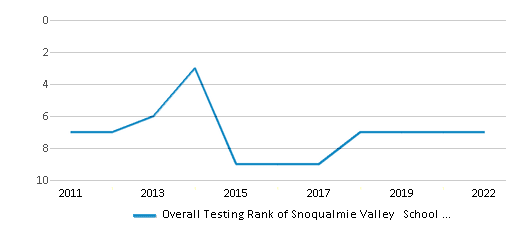
Math Test Scores (% Proficient)
66%
40%
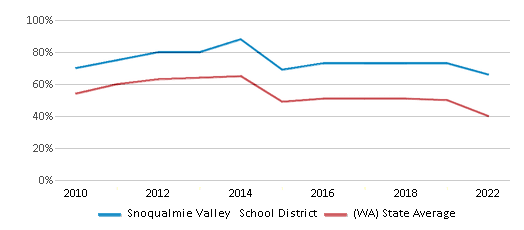
Reading/Language Arts Test Scores (% Proficient)
77%
53%
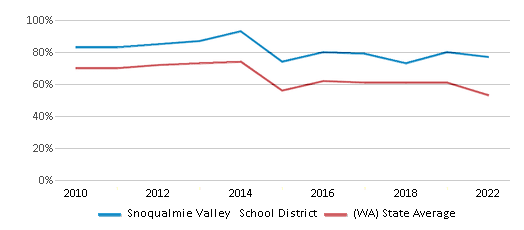
Science Test Scores (% Proficient)
74%
49%
Graduation Rate
93%
84%
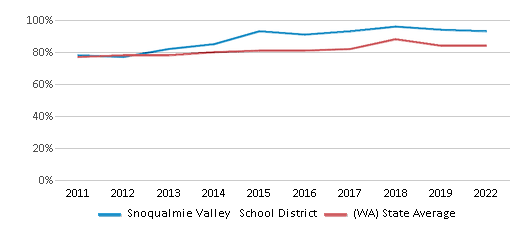
Students by Ethnicity:
Diversity Score
0.49
0.68
# American Indian Students
38 Students
6,221 Students
% American Indian Students
1%
2%
# Asian Students
736 Students
31,721 Students
% Asian Students
10%
8%
# Hispanic Students
705 Students
98,261 Students
% Hispanic Students
10%
26%
# Black Students
84 Students
18,030 Students
% Black Students
1%
5%
# White Students
5,015 Students
191,719 Students
% White Students
70%
50%
# Hawaiian Students
19 Students
5,280 Students
% Hawaiian Students
n/a
1%
# Two or more races Students
541 Students
32,267 Students
% of Two or more races Students
8%
8%
Students by Grade:
# Students in PK Grade:
80
1,298
# Students in K Grade:
493
1,800
# Students in 1st Grade:
502
1,949
# Students in 2nd Grade:
542
2,043
# Students in 3rd Grade:
490
2,225
# Students in 4th Grade:
584
2,376
# Students in 5th Grade:
542
2,423
# Students in 6th Grade:
521
4,808
# Students in 7th Grade:
546
8,534
# Students in 8th Grade:
541
10,258
# Students in 9th Grade:
616
86,766
# Students in 10th Grade:
562
88,753
# Students in 11th Grade:
571
87,580
# Students in 12th Grade:
571
91,784
# Ungraded Students:
-
-
District Revenue and Spending
The revenue/student of $19,980 is higher than the state median of $18,796. The school district revenue/student has stayed relatively flat over four school years.
The school district's spending/student of $18,418 is less than the state median of $19,246. The school district spending/student has stayed relatively flat over four school years.
Total Revenue
$143 MM
$20,715 MM
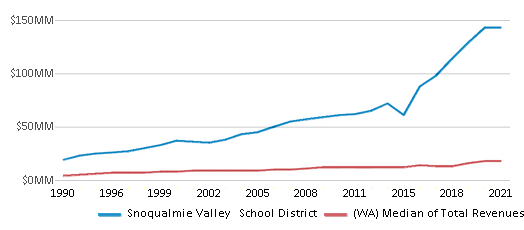
Spending
$132 MM
$21,212 MM
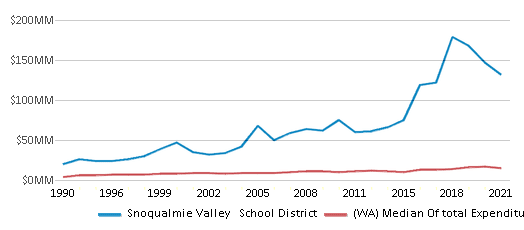
Revenue / Student
$19,980
$18,796
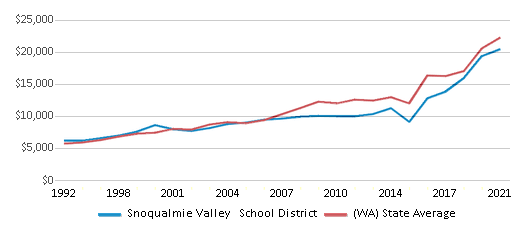
Spending / Student
$18,418
$19,246
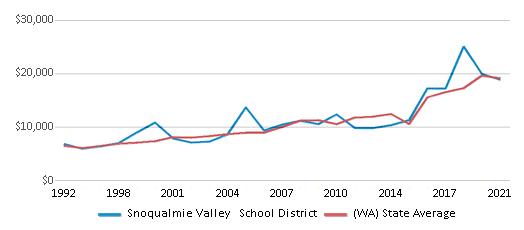
Best Snoqualmie Valley School District Public High Schools (2025)
School
(Math and Reading Proficiency)
(Math and Reading Proficiency)
Location
Grades
Students
Rank: #11.
Mount Si High School
(Math: 59% | Reading: 89%)
Rank:
Rank:
10/
Top 10%10
8651 Meadowbrook Way Se
Snoqualmie, WA 98065
(425) 831-8100
Snoqualmie, WA 98065
(425) 831-8100
Grades: 9-12
| 2,172 students
Rank: #22.
Snoqualmie Parent Partnership Program
Alternative School
(Math: 45-49% | Reading: 75-79%)
Rank:
Rank:
9/
Top 20%10
9200 Railroad Ave Se
Snoqualmie, WA 98065
(425) 831-8440
Snoqualmie, WA 98065
(425) 831-8440
Grades: K-12
| 195 students
Rank: #33.
Two Rivers School
(Math: <50% | Reading: ≥50%)
Rank:
Rank:
7/
Top 50%10
8651 Meadowbrook Way Se
Snoqualmie, WA 98065
(425) 831-4200
Snoqualmie, WA 98065
(425) 831-4200
Grades: 9-12
| 60 students
Rank: #44.
Snoqualmie Access
Special Education School
(Math: <50% | Reading: ≥50% )
Rank:
Rank:
5/
Bottom 50%10
8001 Silva Ave Se
Snoqualmie, WA 98065
(425) 831-8015
Snoqualmie, WA 98065
(425) 831-8015
Grades: PK-12
| 16 students
Recent Articles

Year-Round Or Traditional Schedule?
Which is more appropriate for your child? A year-round attendance schedule or traditional schedule? We look at the pros and cons.

Why You Should Encourage Your Child to Join a Sports Team
Participating in team sports has a great many benefits for children, there is no doubt. In this article you will learn what those benefits are.

White Students are Now the Minority in U.S. Public Schools
Increasing birth rates among immigrant families from Asia and Central and South America, combined with lower birth rates among white families, means that for the first time in history, public school students in the United States are majority-minority. This shift in demographics poses difficulties for schools as they work to accommodate children of varying language abilities and socio-economic backgrounds.





